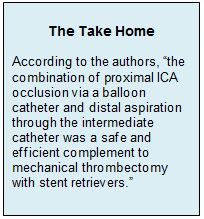Key Points:
- Study looks at new thrombectomy technique (proximal balloon occlusion plus distal aspiration) in acute ischemic stroke
- Thrombus migration is reduced, but only half of patients had favorable outcome at 3 months
Combining both proximal balloon occlusion and distal aspiration during thrombectomy for acute ischemic stroke of the anterior circulation can limit the migration of thrombus fragments into new vascular territory, according to a study published online April 7, 2016, in the Journal of NeuroInterventional Surgery. Still, only half of patients had good functional outcome at 3 months.
“The clinical benefit of endovascular stroke therapy has been proven in several prospective randomized trials,” Sibylle Stampfl, MD, of University Hospital Heidelberg (Heidelberg, Germany), and colleagues. “However, in a relevant percentage of patients, mechanical thrombectomy bears the risk of causing new infarcts in initially unaffected vascular territories through thrombus fragmentation and migration of clot debris.”
The authors report that in previous trials, thrombus fragments have been found to migrate into new vascular territory following thrombectomy using a stent retriever in up to 11% of cases.
Last year, the investigators published a paper on how they successfully reduced thrombus migration to only 2.6% by using the 5-Fr Sofia (MicroVention, Tustin, CA) distal access catheter. “This was most likely achieved by positioning of the intermediate catheter tip in the immediate vicinity of the thrombus,” they wrote. “Thus, the unprotected stent retriever retraction distance was reduced. Furthermore, lost thrombus fragments could possibly be withdrawn by aspiration through the intermediate catheter lumen.”
For this trial, Dr. Stampfl and colleagues again used the Sofia catheter and also added the 8-Fr Cello balloon guide catheter (Covidien, Irvine, CA) for temporal flow arrest of the internal carotid artery. They treated 31 patients with mechanical thrombectomy for ischemic stroke using this technique.
Patients’ mean age was 72.3 years, and all presented with occlusions of the anterior circulation: internal carotid artery (ICA) terminus occlusions in 9, ICA terminus plus middle cerebral artery occlusions in 9, M1 segment occlusions in 10, and M2 segment occlusions in 3. Overall, 18 patients received IV recombinant tissue plasminogen activator (tPA).
Initial TICI score was 0 in all patients, and 96.8% achieved a TICI score ≥ 2b after the intervention. Median National Institutes of Health Stroke Scale (NIHSS) score was 19 at admission and 4.5 at discharge. There were no new thromboembolic complications.
Three months after the intervention, 51.6% of patients had a favorable clinical outcome (mRS score 0-2) and 19.3% had died.
“In our study of 31 patients,” write the authors, “the combination of proximal ICA occlusion via a balloon catheter and distal aspiration through the intermediate catheter was a safe and efficient complement to mechanical thrombectomy with stent retrievers. The procedure was technically successful in a large number of cases. No macroscopic thrombus migration into a new vascular territory occurred. However, the rate of favorable outcome after 3 months was not higher than 50%.”
Source:
- Stampfl S, Pfaff J, Herweh C, et al. Combined proximal balloon occlusion and distal aspiration: a new approach to prevent distal embolization during neurothrombectomy. J NeuroInterv Surg. 2016;Epub ahead of print.
Disclosures:
- Dr. Stampfl reports no relevant conflicts of interest.


